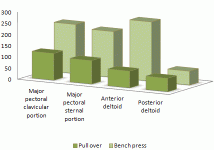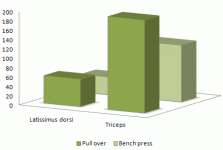Pullovers: bad exercise for the pecs, but good for the triceps
Bodybuilders and fitness fanatics who do pullovers to exercise their chest muscles are wasting their time. Brazilian researchers at the Federal University of Lavras came to this conclusion after comparing the bench-press with the pullover. They discovered that the bench-press is a markedly better exercise for muscles in the upper body than the pullover.
Study
The researchers got 12 experienced strength athletes to perform bench-presses and pullovers [shown here]. The Brazilians had attached electrodes to their subjects' muscles, so that they could see how hard the muscle groups were working.
Results
The bench-press stimulated both parts of the chest muscles better than the pullover did, and also stimulated the anterior delts better. The values on the Y-axis are expressed in microvolts.
The pullover on the other hand was a better exercise for the lats and triceps than the bench-press was. The pullover provided little stimulus to the lats, but the stimulus to the triceps was considerable. So bodybuilders could use pullovers to exercise their triceps muscles.
Conclusion
The researchers don't dismiss pullovers, admitting that they are useful in some cases. "The pullover is indicated as a good transition exercise from the anterior to the posterior portions of the body", they write. "With regard to the adjustment of the pullover in training programs, we suggest its application in agonist/antagonist training to provide take advantage of the transitional potential offered by this exercise."
"In sports, the pullover could be usually prescribed as part of strength training for athletes in many sports modalities, both for performance improvement, enhancement of strength and power, and for the prevention of injuries that may result from repetitive movements above the shoulder line."
"In such situations, glenohumeral joint is often requested due to the exercise specificity degree that is very similar to movements of serving and cutting in volleyball, serving in tennis and pitching in baseball, to name a few examples."
Source: Motriz: Revista de Educacao Fisica, Rio Claro, v20 n2, 200-205, Apr/Jun, 2014.
Bodybuilders and fitness fanatics who do pullovers to exercise their chest muscles are wasting their time. Brazilian researchers at the Federal University of Lavras came to this conclusion after comparing the bench-press with the pullover. They discovered that the bench-press is a markedly better exercise for muscles in the upper body than the pullover.
Study
The researchers got 12 experienced strength athletes to perform bench-presses and pullovers [shown here]. The Brazilians had attached electrodes to their subjects' muscles, so that they could see how hard the muscle groups were working.
Results
The bench-press stimulated both parts of the chest muscles better than the pullover did, and also stimulated the anterior delts better. The values on the Y-axis are expressed in microvolts.
The pullover on the other hand was a better exercise for the lats and triceps than the bench-press was. The pullover provided little stimulus to the lats, but the stimulus to the triceps was considerable. So bodybuilders could use pullovers to exercise their triceps muscles.
Conclusion
The researchers don't dismiss pullovers, admitting that they are useful in some cases. "The pullover is indicated as a good transition exercise from the anterior to the posterior portions of the body", they write. "With regard to the adjustment of the pullover in training programs, we suggest its application in agonist/antagonist training to provide take advantage of the transitional potential offered by this exercise."
"In sports, the pullover could be usually prescribed as part of strength training for athletes in many sports modalities, both for performance improvement, enhancement of strength and power, and for the prevention of injuries that may result from repetitive movements above the shoulder line."
"In such situations, glenohumeral joint is often requested due to the exercise specificity degree that is very similar to movements of serving and cutting in volleyball, serving in tennis and pitching in baseball, to name a few examples."
Source: Motriz: Revista de Educacao Fisica, Rio Claro, v20 n2, 200-205, Apr/Jun, 2014.


